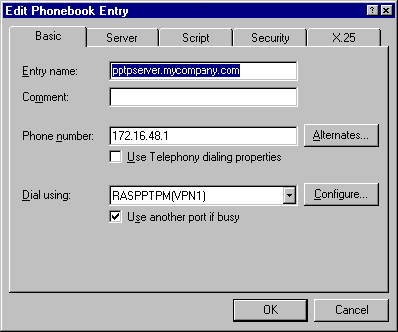
You must create a phonebook entry to connect to your PPTP server by using a VPN device.
Note You do not need to create a phonebook entry for your PPTP server if your computer is not PPTP-enabled and you are using a PPTP service provided by your ISP.
Before starting the following procedures you must have:
· Installed all network protocols (IP, IPX, NetBEUI) used on the private network to which you want to connect.
· Configured RAS to dial out using the network protocols (IP, IPX, NetBEUI) used on the private network.
To create an phonebook entry to dial-up a PPTP server by using a VPN device
1. Click Start, point to Programs, point to Accessories, and then click Dial-Up Networking. (If this is the first phonebook entry, a Dial-Up Networking dialog box appears. Click OK.)
2. Type the name of your PPTP server in Name the new phonebook entry, and click Next.
3. Click I am calling the Internet and click Next. This configures the phonebook entry to use TCP/IP and PPP as the Dial-Up Networking protocols.
4. Select RASPPTPM(VPN1) in the Select the modem or adapter this entry will use box, and then click Next.
5. Type the IP address of the adapter on the PPTP server that is connected to the Internet in the Phone Number box.
Note If your PPTP server has an Internet registered DNS name, you could alternatively enter its DNS name in this field.
1. Click Next, and then click Finish.
2. Verify the phonebook entry by using the following procedure.
Note If you are configuring the VPN device on an ISP server running Windows NT Server version 4.0 that is configured with multiple VPN devices, repeat this procedure for each VPN device.
To verify or edit your phonebook entry for the PPTP server
1. Click More in Dial-Up Networking, and then click Edit entry and modem properties to verify that your PPTP server phonebook entry is correctly configured. The Edit Phonebook Entry dialog box appears, as illustrated in the following figure.

2. Review the information on the Basic tab to ensure that the phone number is correct and that the RASPPTPM(VPN1) device is selected. Make any necessary changes.
3. Click the Server tab.

4. Review the information on the Server tab to ensure that the Dial-up server type displays “PPP: Windows NT, Windows 95 Plus, Internet.”
5. In the Network protocols box, ensure that the network protocols used on your private network are selected. Any selected protocol (TCP/IP, IPX/SPX, NetBEUI) must already be installed on the PPTP client you are configuring. In addition, RAS must be configured to use that protocol to dial out. Note that TCP/IP does not need to be selected unless it is the protocol used on your private network.
6. If you use TCP/IP on your private network, click TCP/IP Settings to display the PPP TCP/IP Settings dialog box. Ensure that the TCP/IP settings conform to the settings required by the RAS configuration on the PPTP server. This includes the Enable software compression and Enable PPP LCP extensions settings
7. Click the Script tab, and then select None. The PPP protocol used in RAS is designed to automate remote logon. If your ISP requires a manual logon, consult your ISP for the correct configuration.
8. Click the Security tab. Click Accept only Microsoft encrypted authentication. The PPP protocol encrypts the user name and password for remote logon. The user name and password used to log on to the current session can be used by selecting Use current username and password. You are prompted by the PPTP server if this box is not selected. Both methods are encrypted and are therefore secure.
Note If you are configuring the VPN device on an ISP server running Windows NT Server version 4.0 that is configured with multiple VPN devices, repeat this procedure for each VPN device.